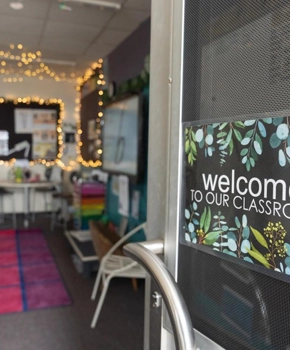[The first year of school] is going to be the foundation of what the rest of school is going to be like. A lot of that little kid's ideas of what school is going be like can actually be formed in that [first year of schooling]. They're experiencing a lot of new things and I think for all kids … especially neurodivergent kids, the first experience of something is really formative. It gets ingrained. It's what you then base every experience from.
Starting School
Autism resources for parents
Starting school is an exciting and important milestone in every child’s life. These resources are aimed at helping families of children on the autism spectrum (diagnosed or undiagnosed) prepare for the first year of schooling. Explore:
- practical ideas to help your child to adjust to new places, routines and experiences
- ways to develop a positive dialogue with your child’s teachers and why it is important
- strategies from educators and experts on navigating this period of change
- perspectives of autistic individuals and families of autistic children.
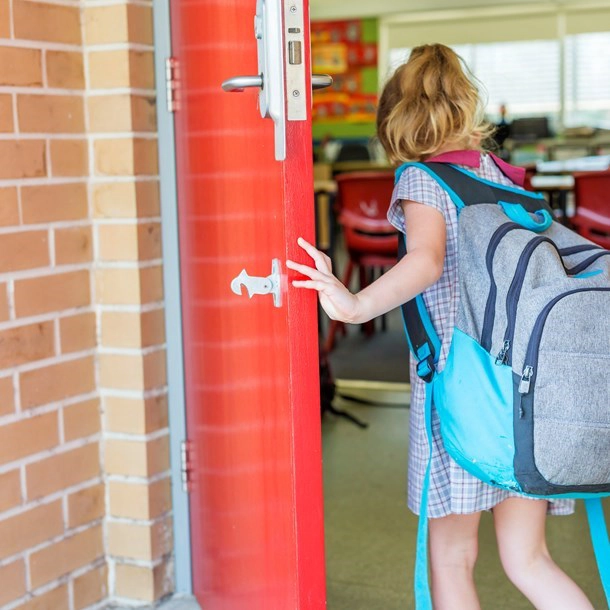
The term ‘neurodiversity’ is often used to describe the natural variation in the way an individual’s brain functions. It refers to the differences in the way people behave, and how they experience, understand and interact with the world around them.
No single person can be neurodiverse – that’s a common misuse of the term. Everyone is different from others, so everyone is neurodiverse, including neurotypical people. The term ‘neurotypical’ simply refers to a person with a more common type of brain (otherwise known as a neurotype) in terms of how they sense the world and people around them, and how they think, feel and respond. When you are neurodivergent, you differ from the ‘typical’ or more common type of brain. Autistic people are neurodivergent, as are people with attention deficit hyperactivity disorder (ADHD) or obsessive-compulsive disorder (OCD), or with learning differences such as dyslexia or dyspraxia. About 1 in every 5 or 6 children has variations in their brain development (raisingchildren.net.au, 2022).
Autistic people are not broken or disordered, they are just different, and may have additional support needs. When we understand and make allowances for neurodiversity, children are less likely to experience difficulties at school and more likely reach their full potential.
Notes on language
Communicate to your school and teachers the language you and your child prefer to use – such as ‘neurodivergent’, ‘autistic’, ‘on the spectrum’, or ‘with autism’. Note that most autistic adults prefer the term ‘autistic’, as it is part of who they are, and seen as part of their identity. You cannot remove autism from a person – autism is part of who a person is.
This resource uses both person-first language (for example, ‘a student on the autism spectrum’) and identity-first language (for example, ‘an autistic student’). We acknowledge that individuals choose how they wish to be identified.
Autism is a lifelong developmental disability and can present in different ways as a child matures. It is generally associated with differences in the way a person learns, thinks, communicates and behaves. An autistic child may have a wide range of strengths, interests, abilities, needs and challenges.
Every autistic child is different. Some may have communication difficulties that prevent them from expressing their needs and feelings in ways others do. They may also have challenging behaviour that places them at risk and impacts their safety and wellbeing at home and at school. Some children also have restricted interests or display repetitive or highly focused behaviours.
Autistic children may have average IQ, or be academically gifted. They may be able to communicate effectively but experience other social challenges, such as with learning to play with other children or understanding the perspectives of others.
Some autistic children may be constantly conscious of sensations that other children are not aware of (for example, sounds, smells, tastes, touch, visual stimuli). On the other hand, they might not notice sensations inside their bodies, such as hunger or pain, in the same way their peers do.
There is considerable variation in the way autistic children’s brains work. For this reason, it is important that a child is provided with individualised support to help them access and participate in learning at school, and feel a sense of belonging.
Autistic children may act in a different way to other children including showing some indicators of autism.
Strengths
Autistic children may also have exceptional strengths, including:
- strong visual skills and ability to pay attention to detail
- problem-solving and logical thinking skills
- advanced memory skills
- hyperlexia (ability to read and understand written language at an early age)
- good understanding of and adherence to rules
- special interests in particular topics
- ability to focus and pay attention for long periods
- exceptional honesty, reliability and loyalty
- ability to focus and pay attention for long periods.
You just need to stop looking at everything as being a deficit, because everything, nearly everything, that could be a deficit can also be a strength.
In some cases, an autistic child may also be diagnosed with another condition. When one or more conditions occur together, they are referred to as co-occurring or co-existing conditions. Co-occurring conditions may occur at different times in an autistic person’s life and have differing impacts on the way they behave and learn. Some common co-occurring conditions seen in autistic children may include language delay speech disorder, developmental language disorder, anxiety, ADHD and motor difficulties. Find out more about conditions that can occur with autism.
Although your child may not develop a co-existing condition, if you notice a change in their behaviour or feel that they are not responding to the supports in place at school, it is important to discuss this with your child’s school. This will help the school to make the appropriate adjustments to help your child to access learning at school. The school can provide support to your child even if they don’t have a formal diagnosis of a disability.
You can take the following steps if you have concerns about your child:
- Let their teacher know about any changes you have noticed at home and establish whether these are also happening at school.
- Meet with the school support team to discuss and decide on supports that might benefit your child. This might include gathering further information about your child before making any decisions. The school might suggest that they collect information through school-based tests or classroom observations.
- Arrange a follow-up meeting to talk about the school’s recommended next steps. If necessary, discuss your concerns with your GP or paediatrician.
For more information go to the 'Talking to your child's teacher' topic below.
Signs and behaviours of autism are often present before a child is 3 years old but might not be detected until a child starts primary school. You may notice that your child is not adjusting to the school environment as expected. Your child’s school might also make similar observations or might not even be aware that your child is finding adjusting to school difficult because your child might behave differently at school and at home.
If you or your child’s school suspect that your child might be showing signs of autism, the next step is to consider a formal assessment. The school may suggest that you make an appointment with your GP who can begin the process of referring you to the appropriate health professional.
Sometimes a team of professionals is required to make a diagnosis together. This involves a comprehensive assessment of your child’s family and medical history, and developmental and functional abilities. An autism assessment will also generally consider your child’s behaviour, their strengths, differences from other children, and challenges they are experiencing at home and at school.
More information and guidelines about the assessment and diagnosis process can be found on the Autism CRC website.
Embracing your child’s neurodivergence involves acceptance, awareness, inclusion and appreciation.
What autism is for someone who never knew and never was exposed to autism before, [it] is just the autistic person's brain probably wired a little bit different to ours. There's nothing wrong with them. There's nothing to fix. But all we need to do is just to help [our son] to live a fantastic and independent and happy life.
Select each title to view the information in the table below.
You are going to learn a lot about autism, including understanding your child’s particular strengths and needs. You will also learn about the school’s obligations in relation to supporting students with disability. You may need to act on behalf of your child to inform the school about your child’s support needs and to ensure they are included as a valued member of the school community.
Maintaining positive and open relationships with members of the school support team will help your child to achieve the best learning outcomes. You might need to be proactive and diplomatic when raising awareness of your child’s needs. The best outcomes are achieved when families and schools work together to support children with diverse learning needs.
Learning about your child’s autism diagnosis is a significant moment in your life. It might take a little while to process what this means for your child and family. You might worry about the impact of the diagnosis on your child’s schooling.
Your child might behave differently to other children and that is totally fine. They shouldn’t be expected to change their behaviours if it doesn’t interfere with their everyday activities.
Your child’s school and health professionals will be able to provide you with information to help you understand more about autism and to learn about the support available for your child. It is likely you will face some challenges as your child grows up but there is a lot of support available to help make your child’s schooling experience positive and enjoyable.
Your child has many skills and abilities that can be celebrated. Your child’s school support team can work with you to identify these strengths and find opportunities for your child to use or demonstrate them at school.
It can be helpful for children to understand that, although they can’t be great at everything, they are likely to have skills that are ‘their thing’! This might be something like having a fantastic memory, amazing creativity, or incredible maths skills.
There are likely to be other children in your child’s class at school who might also learn or act differently. Your child’s teacher and school will be familiar with how to support the unique strengths and needs of all children.
Tasks and activities at school can be adjusted so your child can fully participate. The school support team will be able to work with you and your child to find ways to make sure your child feels supported and included.
Further information
A national guideline for the assessment and diagnosis of autism spectrum disorders
Autism diagnosis for children: a guide
Conditions that can occur with autism
Neurodiversity and neurodivergence: a guide for families
How to talk to your child about their autism diagnosis – the earlier the better
Thinking and learning strengths in autistic children and pre-teens
Topic resource
Indicators of autism [PDF]
Every child should be able to access and participate in their schooling. A disability should not be barrier to those rights.
The Disability Standards for Education 2005 (also known as ‘the Standards’) aim to ensure that every child with disability gets the same opportunities at school as other students. The Standards help ensure support for students with disability, including students on the autism spectrum, so that they can participate in education on the same basis as their peers.
All schools must follow the Standards, as well as the Disability Discrimination Act 1992 (DDA).
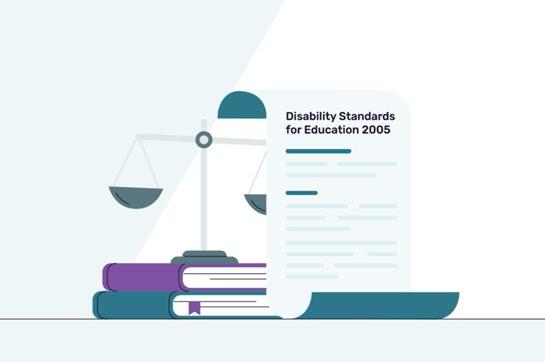
The Standards explain what education providers, including schools, must do to support students with disability.
There are five standards.
Select each of the titles in the table below to find out about the areas they cover.
Education providers must ensure that all students with disability can enrol in school on the same basis as students without disability and without experiencing discrimination.
Schools need to take reasonable steps to assist students with their enrolment, for example, providing opportunities for families and caregivers to visit schools and view students’ classrooms to help them make informed enrolment decisions.
Education providers must ensure that students with disability can participate in school on the same basis as students without disability.
Reasonable adjustments must be made by schools to ensure this is the case. These adjustments could include providing appropriate lighting for students with light sensitivity or making the classroom less busy visually for students who might experience sensory overload.
Education providers must ensure that all students can access the curriculum on the same basis as their peers.
This means that if students need learning experiences modified to meet their individual needs, schools must do so, provided the adjustment is reasonable. One example might be allowing students with disability access to visual timetables ahead of time, so they know their classroom routine.
Regular consultation is important. Schools should consult and communicate regularly with families about a child’s needs when it comes to student learning and wellbeing.
Education providers must ensure that all students can access support services to enable equal access to learning.
Support services can include providing specialist equipment, such as fidget toys and ‘wobble’ stools, or access to learning support programs.
Education providers must ensure that students with disability attend school in an environment that is free from harassment and victimisation.
Schools should take steps to support students with disability by, for example, developing and implementing school policies which deter harassment and victimisation.
Under the Standards, schools must do three things:
-
They must consult with students with disability and their families.
-
They must make reasonable adjustments to help students with disability.
-
They must ensure students with disability are not treated less favourably than students without a disability.
The Standards support you and your child to have fair and accessible consultation and discussion about your child’s education.
A helpful resource to learn more about the Standards is the Practical guide for individuals, families and communities.
Reasonable adjustments are how schools support students with disability. Reasonable adjustments are changes or accommodations which are made to help students access education on the same basis as their peers. Schools are obliged to make reasonable adjustments to support students with disability. Adjustments might include:
- changes to the classroom environment (for example, modifying a corner in the classroom into a quiet space if a child needs a calm corner)
- additional teaching support
- changes to the way things are taught.
More information on reasonable adjustments can be found in the booklet Explaining the Disability Standards for Education.
Your child is entitled to access to, opportunity for and enjoyment of their education at all times. The Standards ensure that:
- you can be heard and consulted, along with your child, about their education
- you are the best advocate for your child and your child is protected by the Standards
- communication is key between families and schools to support your child in their education.
As your child’s caregivers, your love, experience and knowledge of their needs should influence decisions that are made about their participation in the early years of school. Being positive about your child and sharing information with your child’s teacher about how best to support and include your child in the classroom environment will guide planning and support your child's wellbeing. Families have a legitimate role in partnering with their child’s school to advocate for their child and to ensure their own views and the voice of their child are heard.
It is important, particularly in the first terms of primary school, to establish open dialogue with the team around your child. This will allow you to provide information about your child’s strengths and interests, and suggest how the school can support your child to be calm and happy, develop independence and interact with friends. This initial contact provides the groundwork for ongoing communication.
I think in the first year of schooling, when you're so little, it can be really hard to explain how you feel. I have a lot of difficulties with my interoception. It can take me a long time to actually process how I am feeling and then it can take another long chunk of time for me to be able to then explain that to other people.
Families of a child with disability receive a lot of advice about what is good for their child and their education. Students on the autism spectrum need support and understanding in their early years to ensure they have the best chance of success at school. A focus on strengths and interests, rather than the challenges, will help you to think about what a fulfilling life can be like for your child. Involve your whole family and your child in the process.
A vision statement is a short, written description of what your family and your child want for their future and the goals for their education. It clarifies your goals for a positive schooling experience and fulfilling life for your child, and communicates these to others.
Your vision statement can help guide decision-making about your child’s future at school and beyond. Sharing this vision about how you expect your child to participate and engage in learning with their peers will support the development of a positive family–school partnership.
An example of a vision statement for a child beginning primary school:
Our child is included in all classroom activities and receives support to be successful in their learning. They are safe and happy and feel like they belong at school with their friends. Our child’s teachers understand their strengths and adjust the curriculum, teaching approach and learning environment appropriately. Our family is committed to working in partnership with educators at the school.
A vision statement can be reviewed and rewritten as needed as your child matures and their capacity to add their voice to the vision grows.
I think that it's important for young people and children to be involved in advocacy because ultimately it impacts them the most and they can provide the most information about their day-to-day lives. But also I think it's really important because those kids do grow up and one day they'll need to advocate for themselves. And so it's important that they start to learn how they can do that from a younger age.
Create a vision for an everyday life of a child rather than a special life for someone who has a disability. Try to have high expectations rather than placing limitations on what your child can achieve. Your vision should inform building a supportive and natural community around your child.
In creating your vision statement it is important to:
- believe in your child and have a positive attitude and encourage others to as well
- not see disability as a problem that needs to be fixed or cured
- write a vision that will aid family discussions about what is important to have a good life
- share your vision so that others understand the focus is on your child feeling valued, having a sense of belonging and a genuine sense of inclusion
- remember that a vision is not static – it changes as your child matures and faces further transition periods.
A vision statement can be presented in any format that suits your family. You could use this vision statement template to assist you.
Starting school is one of the most important experiences in a child’s life. For you, as a parent or carer, this brings an opportunity to strengthen your relationship with your child and advocate for their needs in the new context of school.
You know your child’s strengths and preferences and how best to support them. Think about how your child might respond to this change, plan your actions in advance, and work with them to make the move to school a positive experience.
Schools are places for both academic and social learning. In the early years of schooling, your child will learn foundational skills and gain knowledge across a range of new subjects. They will also discover new interests and strengths. You can help your child to approach this experience with interest and curiosity.
The social learning your child will learn at school is also important. Your child will enter a social environment that has different expectations. They will learn and use new ways to interact with teachers and peers in different situations. They will develop relationships and friendships with adults and their peers.
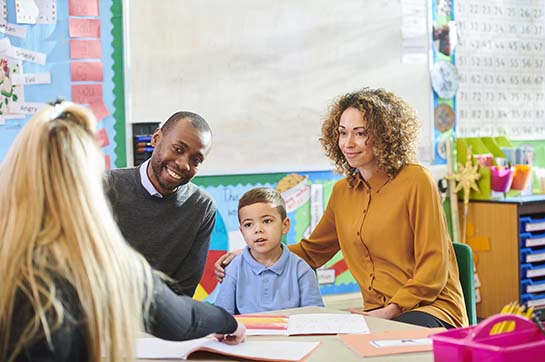
The move to school is different for every child. It is important to allow plenty of time for preparation. To ensure a smooth transition, it is essential to meet the school beforehand. Organising important information about your child and communicating this with school staff early in the transition process will help make the experience positive. For suggestions on sharing information with your child’s teacher, go to ‘Help your school understand your child's needs’ and ‘Talking to your child's teacher’ topics below.
Once the school year starts, it may take several weeks before your child feels comfortable in the new setting. Having positive interactions and building rewarding social relationships with their teacher and peers will help them gain self-confidence and develop a positive attitude towards learning.
With a clear understanding of the academic and social experiences in the new school, you can plan for any support your child may need. Having different family members present for some of the following activities could help your child feel embraced by the family’s support and enthusiasm for this major change.
Some children may require additional support or work their way up to full-time attendance.
School is a very different environment to what families might have experienced before. There’s often less personal contact with the classroom teacher or school personnel than they might have had when their child has been in childcare or kindy. So that’s a big change and a big shift in thinking often for families around the shift in communication. There’s not necessarily that personal handover of your child.
Select each title to view the information in the table below.
- Bigger school grounds with more students across a range of ages
- New spaces, playgrounds and boundaries
- Different locations for some activities, for example, school library, music room, outdoor education, school canteens, toilets, drink fountains
- Noisier, busier spaces (particularly during breaks and before and after school)
- Learning new academic skills
- New teachers and classes with different students
- More instructions and feedback from the teacher
- New types of learning materials for particular activities
- Frequent transitions between activities
- Teaching assistants may not be in the classroom all the time
- Planned and unplanned teacher absences
- More structured learning experiences in class (and typically less play-based free time)
- Participation in activities that take a little longer
- Requirement to finish classroom tasks on time
- Expectation to respond to questions in front of everyone
- Greater use of digital technologies for learning
- Learning new social behaviours through observation
- Expectation to participate in turn-taking games more often
- Expectation to follow peer behaviours such as sharing resources
- Requirement to follow whole-class routines
- Requirement to work in pairs or small groups
- Requirement to follow small-group activity rules
- Independent self-care skills (such as toilet use, eating, grooming)
- Expectation to receive help and help others
- Need to request a break or ask for help independently
The idea of social stories was created in the USA by Carol Gray. Social stories help children understand new situations they will enter. They help them to understand what other people think and feel when their behaviour is what is expected.
Social stories are a useful tool found to be effective for helping young learners adapt to changes in their routine and adapt their behaviours to new experiences. Social stories present information in a respectful and meaningful way for the child to help them understand aspects of the new physical and social educational settings.
Social stories are usually quite short and are made individually for each child, using words and pictures and text that are about them and their experiences. They are never used as a consequence for misbehaviour.
To write a social story you will need detailed information from about the situation you are preparing for. Writing it may take some practice.
Social stories are valuable because they:
- make a new situation more predictable
- make familiar a routine that your child has not encountered before
- provide information in clear steps, so that your child knows what to expect and how they can act, which supports them to try new things
- can help develop skills by explicitly showing and explaining the tasks or actions your child can do
- reduce your child’s anxiety by outlining a clear, set routine.
Creating a personalised social story is a great way to talk about starting school with your child. The stories are proactive tools designed to reduce transition anxiety and help your child build essential knowledge for the new school. They can help children use this knowledge to exercise more control about what is happening when they are at school.
The stories can describe the key places, people and activities your child will encounter in their typical school day, and why they are important. A social story can also explain some of the important social expectations and the unwritten rules and patterns of behaviour expected of them while at school.
The social story guide below provides some hints for creating your own stories. You can make an individualised social story on any topic by creating a booklet, a slide presentation or by downloading and using the blank template below.
This social story is called Getting ready for school in the morning. The aim of this story is to help your child understand what their morning routine will look like on a typical school day, and prepare them for this routine. This can reduce your child’s anxiety and help make school mornings run smoothly. It is supported with discussion notes to help you get the most out of the story.
The story starts with waking up for the day and includes the steps involved in getting ready, such as having breakfast, getting dressed, getting to school and saying goodbye to family.
Add your own pictures
Want to personalise this story with your own pictures? Download the text only version and add photographs or drawings of your own to illustrate it.
Further information
Starting primary school: autistic children
Preparing for school: Childhood
Topic resources
Make a social story [PDF]
Getting ready for school story [PDF]
Discussion notes [PDF]
When your child starts school, it can be helpful for teachers and other school staff to understand as much as possible about their individual skills, strengths and interests.
You have the greatest understanding of your child, and sharing this knowledge will help:
- your child settle into a new learning environment
- your school to understand how they can build a positive relationship with you and your child
- your school to work with you to plan and implement support for your child’s learning
- provide an opportunity to discuss any potential barriers to learning that your child might experience.
Establishing an open dialogue with your child’s teachers early in your child’s schooling will help everyone deliver the best outcomes.
A student profile is a short document that summarises your child’s strengths, interests and preferences. It can be a valuable tool for the adults who will have contact with your child at school. The profile provides an opportunity for your family and your child to introduce yourselves, and explain your child’s aspirations and passions. It also provides opportunities for you to address any assumptions people might make about your child and to have a say about how they could be supported at school.
Student profiles can be presented in many different formats. Your child’s preschool or kindergarten will have probably developed a transition statement as part of their required processes. Sometimes it is formal document referred to by a different name such as student needs profile, learner profile or one page summary.
Sharing the student profile
You can decide who has access to the student profile. You may only want to share the information with your child’s classroom teacher. However, it might also be beneficial for your child if other adults in the school know who they are and the kind of help they might like at school. This might include other teachers, members of the school leadership team, education assistants, support staff (for example, library staff, sick bay attendants), relief teachers and adults working in administration roles.
It is a good idea to review the information each year as your child’s interests change and they begin to grow in independence. What works for them one year in one classroom might not be the same the following year. You might prefer to update the student profile at home with your child or in partnership with the school support team. Importantly, it is helpful to include your child’s perspective. Where possible, involving them in the process of developing the student profile is beneficial for both your child and the adults working with them at school.
There's still a really important need for the parent and the educator to come together to have that sort of shared understanding, to get to know the child, their strengths, their challenges, their needs … having some shared discussion about what can we do to provide support for that little person to be happy and successful and to have that sense of belonging at school.
You may want to create a personalised profile to introduce your child to their new school that reflects your child’s point of view. It can include photographs or be illustrated with your child’s artwork and be as colourful and as individual as your child.
You could use this Student profile template. After you complete it, you can print it and share it with your child’s teacher or school support team. It is very helpful to provide this information as early as possible so that the school can individualise support for your child to enable them to access and participate in school life.
Open a dialogue
Sharing and discussing your student profile is a useful way to open a dialogue with your child’s teachers.
Having my parents be able to provide a lot of information about, 'Well, this is what Ashton is like at home and this is what they need. And well actually they're really good at these things. So, if they're not doing well in the classroom, something else must be going on.' As parents, you've got so much of this expert knowledge that you can share and be a resource for schools. Don't sell your own knowledge short, because in the early years only you really know the ins and outs of your child's day to day.
What to include
The student profile document generally includes some key information about the child such as:
- skills and strengths
- interests and likes
- hopes and wishes
- how they like to play (for example, playing with others, being alone, ‘chilling out’ in a quiet area, being active outdoors)
- things that they don’t like or that might trigger them
- what makes them feel excited, happy and cheerful, and how they might express these feelings
- what makes them feel grumpy, frustrated, anxious or angry, and how they might express these feelings
- how they like to learn and what helps them to learn best
- things that make it hard for them to learn (for example, communication difficulties, hypersensitivities)
- how they would like to be supported at school (including in the classroom and the wider school environment).
You may choose to include information, including diagnostic or clinical information, that you would like to be kept confidential. If so, please be clear on how you want this information handled or shared before you share it.
You know your child best. Sharing observations with your school – and communicating your child’s strengths, challenges, differences and needs – helps to build understanding, reduce stigma and increase acceptance. Information about your child can help your teacher and school provide the best possible support for your child.
It’s important to know that accommodations and adjustments to classrooms can benefit all children, not just autistic children.
Communicate to your school and teachers the language you and your child prefer to use such as ‘neurodivergent’, ‘autistic’, ‘on the spectrum’, or ‘with autism’. Note that most autistic adults prefer the term ‘autistic’, as autism is an important part of their identity. Autism is not something you can ‘remove’ from a person – autism is part of who a person is.
You know your child best. Sharing observations with your school – and communicating your child’s strengths, challenges, differences and needs – helps to build understanding, reduce stigma and increase acceptance. Information about your child can help your teacher and school provide the best possible support for your child.
It’s important to know that accommodations and adjustments to classrooms can benefit all children, not just autistic children.
All children starting school need to be able to do some tasks independently. Observing and taking note of your child’s ‘starting school’ skills will help you to identify their strengths and abilities, and identify possible areas of support when starting school. The Starting school skills list below can help you to then communicate these observations to your child’s school and teacher.
Observing indicators of autism
As a starting point, consider any indicators of autism your child might display. The Family observation guide can help you to observe and record your child’s communication style, interests, repetition and routines, and whether they have any sensory processing or motor differences that need to be taken into consideration at school.
Your child may already be receiving professional support. Discuss what information is appropriate to share with the school.
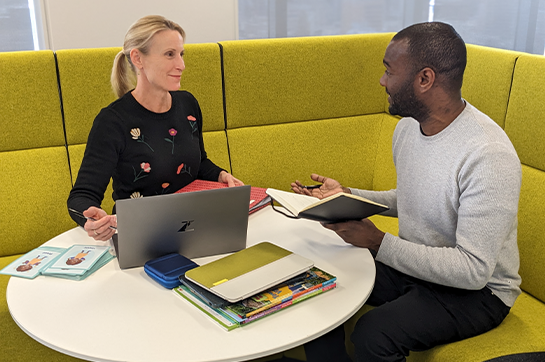
When speaking with your child’s teacher, it can be helpful to keep in mind the environmental and social differences between school and home. For example, an autistic child might come up against more challenges when eating in a school environment than they do at home. Due to sensory sensitivities, a child might find the smell of another child’s food overwhelming. They might be taking medication which affects their appetite, or struggle to open packets or containers.
Eating requires attention, and sometimes differences in executive functioning in autism can mean a child is easily distracted from the task of eating and drinking. Or they might eat and drink more slowly than peers. Some children might find eating and drinking in a large group overwhelming due to sensitivities or find that they do not have the communication tools required to ask for help.
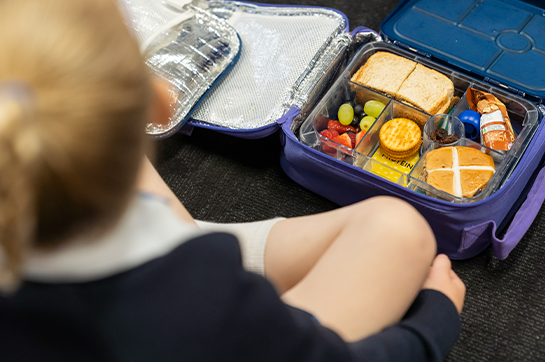
Sometimes children can find it intimidating to approach their teacher when they need to do something, such as going to the toilet and managing their clothing. This can make them anxious and avoid what they need to do. It is worth considering that your child establishes an alternative way to let their teacher know they need something (for example, a gesture, hand signal, or putting a token in a designated bucket).
While some matters can feel quite private as a family, teachers want to support and accommodate the needs of your child to help them flourish.
Consistency and predictability build a strong foundation for autistic kids to feel safe at school. So, if there are any strategies, key phrases, signs or visual supports that help your child feel comfortable, it’s great to let the school know.
Sometimes, though, it can be hard to communicate about such a broad range of things to your child’s teacher. The Conversation starters linked below can be a good starting point, in conjunction with the Family observation guide which allows you to document your observations of your child.
Further information
Sharing an autism diagnosis with the school [PDF]
Topic resources
Starting school skills [PDF]
Indicators of autism [PDF]
Family observation guide [PDF]
Conversation starters [PDF]
Every child varies in their readiness for school and adapts to the school environment differently. You may find that your child becomes more comfortable with familiar routines at school over time, but they might find changes to a ‘typical’ school day a bit more challenging.
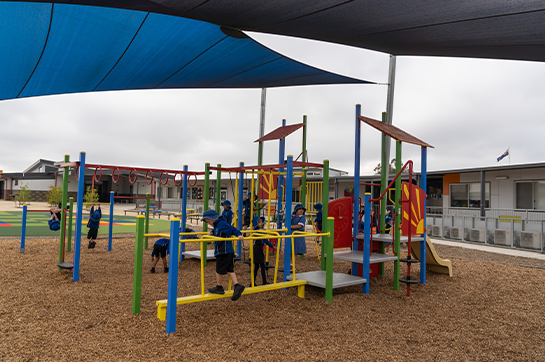
Schools are busy places and there will be times when there may be disruptions to the usual school routine. Change can be stressful for most children, so it is important to monitor your child’s responses arising from these events. Some changes may be expected (such as upcoming school events, planned release of teacher from class for planning), while other disruptions may occur with little or no warning (for example, teacher is away sick).
Building a positive partnership with your child’s school from the start is an important step. By sharing your knowledge with your child’s teachers and support team, you can plan and prepare together to help make changes to routine more manageable for your child.
Think about how your child might respond to these different occasions and what could help to set them up for success. You don’t need to plan for all of these at once. Just be sure to ask the school to let you know in advance when different occasions are planned so that you can work together to prepare your child.
Common events that may take place at school
- School assemblies
- Themed dress-up days (such as Book Week parade)
- Sports days and carnivals
- Cultural and religious events, festivals and ceremonies
- Incursions (for example, visiting mobile farm, visiting performers)
- Special visitors to the school (such as parents’ days, guest speakers)
- A new adult in the classroom (for example, relief teacher, education assistant, class helper)
- Events that involve food (such as class parties, ordering food from the canteen, cooking activities)
- Combined class timetables (perhaps due to weather, special activities)
- Immunisations
- Practice fire drills
- Building works
- Specialist lessons in different parts of the school (such as physical education)
Events that may occur away from school
- Excursions (for example, museum, concerts)
- Visiting places in the local area
- Sports events (for example, inter-school sports carnivals, swimming lessons)
- Periods of remote learning
- School camps or trips
Note: Some of these events might be considered part of the normal school routine in some schools and may require moving to a different space in the school or involve specialist teachers or visitors.
Each child reacts differently to changes in routine and this can also depend on how they are feeling that day. They may be feeling tired or overwhelmed by social or sensory demands. Some children find even small changes in routine can be unsettling, while for others it is larger changes that are challenging. Moving from one activity to another or leaving a task unfinished can also make some children feel unsettled. It is helpful for everyone to know what signs may indicate that your child is feeling stressed. Here are some common examples of signs of stress to look out for:
- Difficulties communicating what they are feeling
- Asking lots of questions
- Avoiding new activities
- Increased stimming
- Talking about their favourite interest more than usual
- Increased anxious behaviours, excessive worrying
- Complaining of being tired more often than usual
- Unexplained illness (for example, complaining that they are too sick to do something)
- Teachers speaking with you about observing behaviours that are out of character for the child while at school (such as covering ears, hiding, running away, shutting down, shouting, refusing to follow instructions or school rules)
- School refusal
- Unusual changes in behaviour
- Change in sleep patterns
- Refusal to move to classes or different spaces
In the following example, we take a closer look at the school assembly and how this different occasion might affect a child.
What happens at a school assembly?
A school assembly is usually a large meeting of students, teachers, other school staff, and often families and other members of the school community. It is a time for the school community to gather to share news and information, celebrate achievements, and discuss other matters relating to the school.

While some children might find this special event exciting and interesting, for others it can be quite overwhelming. The space can be loud, busy, smelly, bright, hot and crowded, or just seem a bit disorganised, as everyone comes in and finds a place to sit. The floor may feel gritty or cold and sitting on the floor may be uncomfortable. Someone might make an announcement over the microphone. The microphone might be too loud. Overhead lights might be buzzing. There might be noise outside. Traffic. Birds. Wind. Rain. Temperature.
Then there are the formalities that follow. There might be an Acknowledgement of Country. Then there might be a national anthem, school pledge or prayer or even a school band playing. Everyone might have to stand up then sit down again and there might be lots of shuffling and scraping sounds while everyone moves. Then there is more talking. Maybe some clapping or cheering. Announcements. Information. Awards. Guest speakers. More clapping. Sometimes everyone will be silent. And then more talking again.
The floor or chair might feel uncomfortable, and it might feel like a long time to have to sit still and be quiet. It could be difficult to focus on the assembly with so many other distractions. There might be a designated space to sit that is not close to the toilet. Other children and adults will seem like they know what to do. It might feel quite confusing and a bit too much to take in!
Talk with the teacher/support team about:
- details of the event, including where it will be held, how long it will be and expectations for your child at the event
- whether a family member or caregiver should attend with your child
- your child’s possible triggers (if known) and suitable calming activities, comfort or fidget toys that your child can access during the event
- how your child can ask for help or take a break, especially if they have difficulty communicating their needs
- whether your child can access a quiet area if they need it
- who your child can go to if they need adult support
- how to communicate with you if needed during the event
- visiting the location in advance, and if appropriate, with your child
- developing a plan together to support your child when they feel overwhelmed
- making a time to talk with your child’s teacher after the event to discuss what worked and what might need to change next time
- discuss options for your child to watch a live feed of the event from calm space at school.
Prepare your child
- Talk to your child about upcoming events and let them know if there is going to be a change in the usual routine. Reassure your child that most children feel a little nervous when they experience new situations at school.
- Use a daily planner at home, to explain what changes in routine are likely to happen. This could also be done visually on a calendar or in a social story.
- Have some ‘what if’ discussions with your child. For example, what they could do if something does not go to plan, or if they are put into situations with people who they don’t know?
- Practise some strategies your child might be able to use at school if they find a special occasion is overwhelming (for example, five-finger breathing, using a fidget toy).
- Roleplay together with toys or by acting to help your child understand what the new situation might be like.
- Get organised the night before to help your child feel calm on the morning before the new occasion. You could lay out the different clothes your child will wear or tell a bedtime story and make up a happy story about the event.
- Create a social story with the school to prepare your child for upcoming changes. Go to the 'Help your child prepare for school' topic above to find out more about social stories.
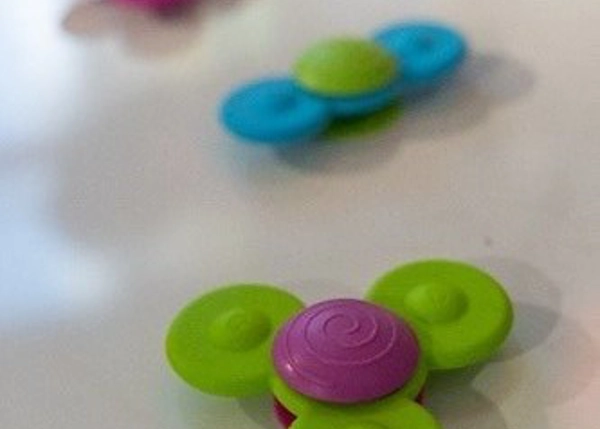
Fidget toys can be helpful for some children.
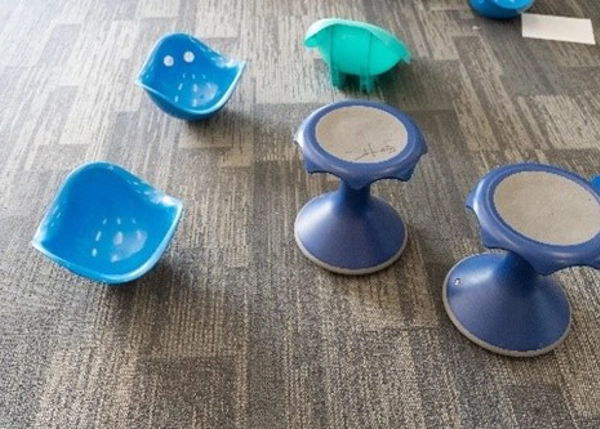
Equipment such as wobble seats can help children during periods where movement is restricted.
Checklist
Which of these strategies might help prepare your child for different occasions at school? The Different occasions at school checklist below provides a list of useful suggestions. If there are other strategies that are helpful for your child, add them at the bottom of the list.
It can be helpful to organise and document your advice when talking with the teacher, and send the plan to the teacher in advance of the event. See, for example, the caregiver’s completed Planning for change sample form for a school assembly.
Remember that different events may require different planning.
Use the Planning for change: Families form to record your advice.
Topic resources
Different occasions at school checklist [PDF]
Moving from a familiar play-based environment to a new primary school can be challenging for many children. For children on the autism spectrum, understanding this change can be overwhelming and can have an impact on their emotional and behavioural responses.
Emotions affect children’s behaviour in a number of ways. Young children on the autism spectrum are still learning to notice and recognise their emotions. They need support to understand and manage their emotions in positive ways. Behaviour that is difficult to manage tends to happen when young children are not coping with their emotions.
Children might become overwhelmed by what they are being expected to do, by the demands of the environment, or difficulties they have in expressing what they need. Sensory experiences can be anything from enjoyable to highly distressing for young children, even when they can’t recognise or name how they feel. The way people communicate with your child at these times can either support them or increase the stress and distress they feel.
Emotions tend to be related to experiences, social needs and personal wants. Emotions are complex brain and body states that involve three distinct responses:
- An experience results in body and brain responses usually followed by an expressive response (behaviour).
- The body and brain response is what we normally call an emotion. For example, if something happens that makes someone happy, that feeling of happiness is signalled to the person through their body and brain responses.
- The body’s chemical reaction in most people will typically be the same but the body responses are more individual, with no two people feeling any one emotion exactly the same way. One person may feel happiness in their face and stomach, while another may feel it in their hands and face.
Interoception, or the ability to sense signals from within the body, is very important in emotional awareness. By paying attention to changes in the body, such as the heartbeat speeding up or tightness in the chest, children can learn to associate these sensations with different emotions. Families and caregivers can help with emotional development by naming emotions, modelling healthy ways to respond to emotions, and giving children opportunities to practise regulating or managing their emotions. Modelling emotions for children can include reading stories, and talking about your own and others’ emotions and how you recognised the emotion.
The use of emoticons and emotional expression toys can help children learn words connected to emotions, but in themselves these do not help children learn to recognise and understand their own emotions.

Here are some simple ways you can help your child to recognise their emotions:
- Name and label emotions, both their own and others', and discuss how emotions can affect behaviour. For example: ‘I wonder if your sister is angry at the moment, she is banging and yelling. She often does that when she is angry.’
- Talk about ways to regulate and express emotions in a constructive way. For example: ‘I am very stressed today, so I’m going to do some belly breathing to calm down before I go off to work.’ It is important to show children how to express anger and frustration in helpful ways rather than trying to prevent these emotions from happening.
- Model healthy emotional regulation and strategies to return to calm. For example: ‘I can see that it’s really frustrating trying to zip up your backpack. I like how you came and asked me for help. Let’s do it together so hopefully it will be less frustrating next time.’
- Explore social and emotional skills through activities like role-playing, reading books, viewing videos or television and playing games together. Talk about the social rules in these activities that children on the autism spectrum can miss, such as taking turns. Or talk about a character’s actions and the impact they have on others.
- Use photographs or drawings of different emotions to play games that link responses to emotions.
- Talk about body responses to an emotion, for example, ‘You look worried. Are you feeling sick in the tummy?’
We often make assumptions that younger children or children who are minimally verbal or have no language can't give an opinion, but often they're giving an opinion with their behaviour. And through that behaviour, we can actually help to model better ways to provide or express their views on things.
Children, like most people, can become more stressed, distressed or overwhelmed when they are unwell, tired or hungry. These experiences for young children can include:
- changes in routine or environment
- sensory overload
- difficulty with social interactions and communication
- overstimulation from technology or screens
- unfamiliar or challenging activities or tasks
- unfamiliar people or places
- unmet support needs in any area.
- Provide a quiet and calm space for the child to go to that is their ‘safe space’.
- As a break, encourage sensory regulation activities such as wearing headphones, deep breathing, stretching, stimming or fidgeting.
- Make sure there is some free time during the day when your child can take a break to do something they are interested in and that makes them feel calm, safe and happy.
- Encourage your child to do something they enjoy, such as playing with a toy or listening to music.
- If your child is interested, being involved in activities such as sports or hobbies can help build emotional regulation and social skills. If they are not interested, this may result in them being more overwhelmed.
- Do some mindful body awareness activities, such as belly breathing and hand stretches.
- Encourage physical activity, such as going for a walk or playing outside.
- Create a visual schedule or countdown to help the child understand when a break is coming.
- Provide some downtime for relaxation after school or other activities.
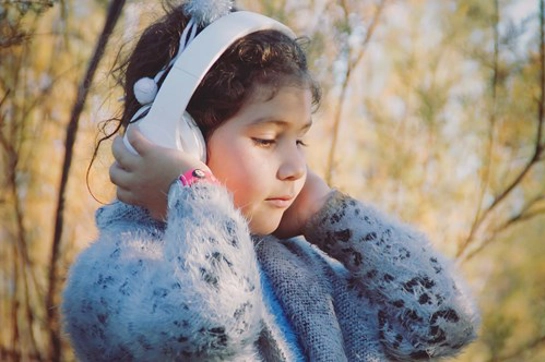
Featured videos
Understanding neurodiversity and autism
Using social stories to help your child prepare for school
Advocating for your autistic child's needs at school
Educator resource
Starting School
